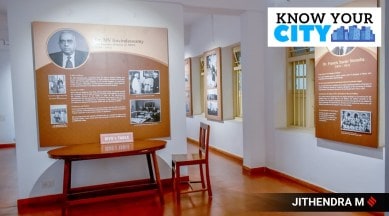Stay updated with the latest - Click here to follow us on Instagram
Know Your City: Tracing Bengaluru’s mental health journey at NIMHANS Heritage Museum
The NIMHANS Heritage Museum showcases how the institute evolved through the years.

The history of treatment of mental health in Bengaluru goes back all the way to 1848 as seen in a lunatic asylum in the building of what is now the State Bank of Mysore and documented at the National Institute of Mental Health and Neurosciences (NIMHANS) Heritage Museum.
The asylum itself was part of an existing hospital at the time for peons, paupers, and soldiers. By 1926, a year before the Maharaja’s Silver Jubilee and the many construction projects that followed it, a plan for a new hospital building was approved at the site where NIMHANS stands today.
monthly limit of free stories.
with an Express account.
NIMHANS in its modern incarnation would finally come to exist in 1974 after a merger with the 1954-established All India Institute of Medical Health (AIIMH).
In 1926, the Mysore Government Mental Hospital, as it was known in those days, was also the origin of the green spaces existing in the area today, designed by the then superintendent Dr Francis Noronha and German botanist Gustav Krumbiegel.
The moving force behind the original asylum was an East India Company officer, Charles Irving Smith. His diaries are today perhaps some of the earliest records kept in Bengaluru of mental health and its treatment.
The mental health infrastructure existing at the time seems to have been a cut above what one might expect in an era before modern understanding. But even in the 1900s, the facilities here were unparalleled in the rest of the country, which had no equivalent facilities at the time.
Located in what was once the 1962 Children’s Pavilion of NIMHANS and split up into seven different zones, the Museum represents the progress of the institute through the eras. The Heritage Museum, NIMHANS also documents evolving mental health treatment and the various pieces of equipment in use at different periods of time.
The Museum preserves many early items used in the treatment of patients, such as the 19th-century patent magneto-electric machine used for electrotherapy treatments. Another device, which would perhaps not be recognised today, is a memory drum, a rotating device that would record responses to assess memory. Also on display is an early version of Boyle’s apparatus, a device used to anaesthetise patients.
Other items from an earlier era of medicine include a tachistoscope, which would use a falling “door” to measure the response time for visual stimulus, and cards for the Blacky Pictures Test developed in 1947, a set of cards displaying a dog intended to test children.
The Museum also records the earliest directors of its various incarnations – Dr Francis Noronha of the Mysore Government Mental Health Hospital, Dr M V Govindaswamy of AIIMH, and Dr R M Varma, first director of NIMHANS. Curiously, the displays also include some of the furniture used by Dr Govindaswamy at the AIIMH.
It also commemorates patients with images of the items they left behind.
They include earrings of a recovered child, a woman who did not take her mangalsutra with her, and perhaps most poignantly, the War Medal 1939-1945 belonging to a World War II veteran whose family never came to take him home. The War Medal is a decoration awarded to Commonwealth citizens who served in the armed forces or merchant navy for at least 28 days.